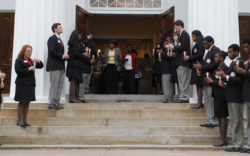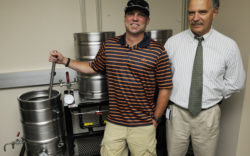A two-year downtown streetscape project starting this week will bring wider sidewalks, fancier bike racks, brighter lighting and updated waterlines to Clayton Street. But first, the two-phase project is going underground.
“They won’t see anything,” says Gary Duck, director of the Athens-Clarke County Public Works Department. “All we’re doing is under the road. They might see a patched road, but that’s about all.”
The first phase of the $7.1 million SPLOST project—updating water and sewer lines on East Clayton, North Jackson and Wall streets—started Tuesday, Jan. 21 and will last until August 2014. Officials are trying to avoid working during the start of the University of Georgia school year and football season, when downtown merchants are busiest.
The road will be dug up half a block at a time, moving from North Lumpkin Street toward Thomas Street, Duck says. This phase will involve replacing the 100-year-old water line with a new, larger line. Work will continue from 7 a.m.—7 p.m. daily, closing one lane of traffic, but the lane will be reopened at night. Duck says working a half-block at a time should limit disturbances to traffic.
Concerns from storeowners regarding the first phase of the project have been limited, Duck says. Because work will mainly take place in the road, most concerns were voiced over the possibility of increased traffic.
At a Monday, Jan. 13 meeting about the project, most discussion surrounded Phase Two, involving storm drain and streetscape improvements and taking place next year from January–August 2015. That is when the visible changes and alterations to the sidewalk come in. The streetscape portion of the project will include lighted bollards, LED streetlights, new bike racks and wider sidewalks.
“They [the project planners] did get comments from all the shop owners, and of course one was ‘Don’t take all our parking away. Don’t reduce the parking spaces,’” says Brian O’Connor, senior transportation engineer for T.Y. Lin International, a company that is consulting on the project. “Others were making sure that access is open to all the businesses at all times, if at all possible.”
Widening the sidewalks will reduce the number of on-street spaces by 18, O’Connor says.
The sidewalk construction also means the 43-year-old Darlington oak and ginko trees on Clayton Street will have to be cut down next year.
Roger Cauthen, administrator of the ACC Landscape Management Division, says the construction will require all trees to be removed from the area eventually. They’ll be removed and replaced incrementally along with the sidewalk reconstruction, about a half block at a time.
“When that [construction] happens, there will be so much demolition that it will require a reconstruction of the curb, sidewalks, the streets, so trees will be returned to the streetscape scene,” Cauthen says.
Arborists agree that it would be nearly impossible to preserve the oaks and gingkoes along Clayton. “Transplanting a tree that size is not practical and nearly impossible,” says John Ritzler of New Urban Forestry. “The size of the root ball that you would have to dig up to keep that tree alive while moving it would probably weigh about 10 tons. The amount of careful excavation and root pruning would be substantial. And still, the risk of killing the tree while moving it would be very high.”
Planting younger trees would have a more “positive benefit” than attempting to save the older trees, Ritzler says. “The thing about trees like that [in an urban environment] is they do need to cycle in and out on a regular basis, in a functional way, to create that shade in a limited space in that downtown environment,” he says.
The trees will be replaced as quickly as possible, Cauthen says, and will be as large as possible. O’Connor says the new trees will have a 10-inch trunk diameter, though officials haven’t decided what species to plant.
“The trees that will be replanted will be as large as we can conceivably purchase them from tree nurseries,” O’Connor says. “A good comparison is the trees that are on Broad Street right now and the trees that are on the section of Clayton between Pulaski and Lumpkin Street. Those trees are in the 10–12 year range.”
Like what you just read? Support Flagpole by making a donation today. Every dollar you give helps fund our ongoing mission to provide Athens with quality, independent journalism.










